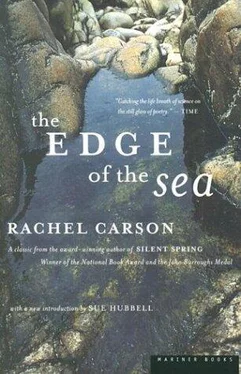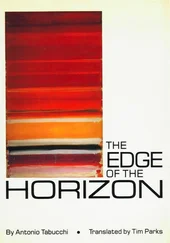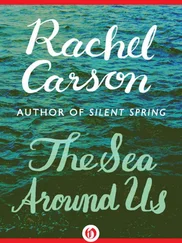A third class of the mollusk phylum consists of the cephalopods, so unlike the snails and clams that superficially it is hard to reconcile the relationship. Although ancient seas were dominated by shelled cephalopods, all but one (the chambered nautilus) have now lost the external shell, retaining only an inconspicuous internal remnant. One large group, the decapods, have cylindrical bodies with ten arms; they are represented by the squids, the ramshorn shell, and the cuttlefish. Another group, the octopods, have baglike bodies with eight arms; examples are the octopus and the argonaut.
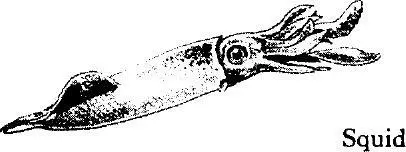
The squids are strong and agile; over short distances they are probably the swiftest animals of the sea. They swim by expelling a jet of water through the siphon, controlling the direction of motion by pointing the siphon forward or backward. Some of the smaller species swim in schools. All squids are carnivorous, preying on fish, crustaceans, and various small invertebrates. They are sought by cod, mackerel, and other large fish, and are a favorite bait. The giant squid is the largest of all invertebrates. The record specimen, taken on the Grand Banks of Newfoundland, measured about 55 feet including the arms.
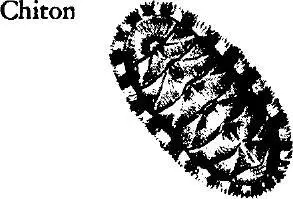
Octopuses are nocturnal animals and, according to those most familiar with their habits, are timid and retiring. They live in holes or among rocks, feeding on crabs, mollusks, and small fish. Sometimes the location of an octopus den may be discovered by the pile of empty mollusk shells near the entrance.
The chitons belong to a primitive order of mollusks, the Amphineura. Most of them wear a shell consisting of eight transverse plates bounded by a tough band, or girdle. They creep sluggishly over rocks, scraping off vegetation. At rest, they settle into a depression, blending so well with their surroundings that they are easily overlooked. They are sought as food (sea beef) by West Indian natives.
The fifth class of mollusks consists of the little-known scaphopods (tooth shells or tusk shells), which form shells resembling an elephant’s tusk, from one to several inches long and open at both ends. They dig into sandy bottoms, using a small, pointed foot. Some specialists think their structure may be similar to that of the ancestors of all mollusks. However, this is a field for speculation, since the principal classes of mollusks were all defined early in the Cambrian, and clues to the nature of the ancestral forms are exceedingly vague. The tooth shells number about 200 species, and are widely distributed in all seas. None, however, are intertidal.
Chordata: Subphylum Tunicata
THE ASCIDIANS, or sea squirts, are the most common representatives on the shore of that interesting group of early chordates, the Tunicata. As forerunners of the vertebrates, or backboned animals, all of the chordates have at some time a stiffening rod of cartilaginous material, an evolutionary forecast of the vertebral column which all the higher animals were to possess. The adult ascidian paradoxically suggests a creature of low and simple organization, with a physiology somewhat like that of oysters or clams. It is only in the larva that the chordate characteristics are clear. Though minute, the larva strongly resembles the tadpole of a frog, possessing a notochord and a tail and swimming actively. At the end of the larval period it settles down, becomes attached, and undergoes metamorphosis to the much simpler adult form, in which the chordate characters are lost. This is a curious phenomenon of evolution, which seems to be degenerative rather than progressive, with the larva displaying more advanced characteristics than the adult.

The adult sea squirt is shaped like a bag with two tubular openings or siphons for water intake and outgo, and a pharynx perforated with many slits through which water is strained. The common name refers to the fact that when the animal is disturbed it contracts sharply, forcing jets of water out through the siphons. In the so-called simple ascidians the animals live as separate individuals, each enclosed in a tough covering or test of material chemically akin to cellulose. Sand and debris often adhere to this test, forming a mat in which the actual shape of the animal is seldom apparent. In this form they often grow profusely on wharf pilings, floats, and rocky ledges. In the compound, or colonial, type of ascidian many individuals live together, embedded in a tough gelatinous substance. Unlike a group of simple ascidians, the various individuals of a colony are derived by asexual budding from one individual, the founder of the colony. One of the commonest compound sea squirts is the sea pork, Amaroucium, named from the usually gray, gristly appearance of its colonies. These may form a thin mat on the under side of a rock or, offshore, grow erect, forming thick slabs that may break off and be carried in to shore. The individuals composing the colony are not easily seen, but under a lens pits in the surface appear, each the opening through which a single sea squirt communicates with the outside world. In the beautiful compound sea squirt Botryllus, however, the individuals form flowerlike clusters, easily visible.
Acmaea testudinalis
Actinopyga agassizi
Agarum turneri
Alaria esculenta ,
Alcyonarians
Alcyonium digitatum
Algae; coralline (sp. Lithothamnion ), ( see also Seaweeds)
Amaroucium sp.
Ammodytes americanus
Amphipods
Amphithoë rubricata
Amphitrite figulus
Anadara ovalis
Anadara transversa
Anemone, sand ( Cerianthus americanus ), ( see also Sea anemone)
Angel wing ( Barnea costata )
Anomia simplex
Anthozoans
Anurida maritima
Aphrodite aculeata
Aplysia dactylomela
Apuleius
Area zebra
Arenicola marina
Argonauta argo
Aristotle
Arks
Arthropods
Ascidians
Ascophyllum nodosum
Asterias forbesi
Asterias vulgaris
Astrophyton muricatum
Atlantic coast, geologic history of; topography of
Atrina rigida or Atrina serrata
Amelia aurita
Balanus balanoides ; enemies; habitat; reproduction
Barnacle, acorn or rock ( see Balanus balanoides ); gooseneck ( Lepas fascicularis )
Barnea costata
Barracuda
Basket star ( Astrophyton muricatum )
Beach fauna
Beach flea ( Talorchestia longicornis )
Bears Bluff
Bêche-de-mer
Bird Shoal
“Black sands”
Black zone of shore
Blackfish
Blenny, beach-hopping
Boat shell ( Crepidula fornicata )
Boreal zone
Botryllus schlosseri
Brevoortia tyrannus
Bristle worms,
Brittle star; daisy ( Ophiopholis aculeata ); West Indian ( Ophiocoma echinata )
Bryozoans
Buccinum undatum
Busycon canaliculatum
Busycon carica
By-the-wind sailor ( Velella mutica )
Byssus cord
Callianassa stimpsoni
Читать дальше
